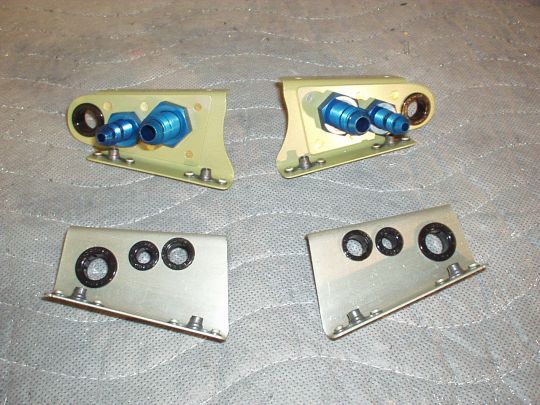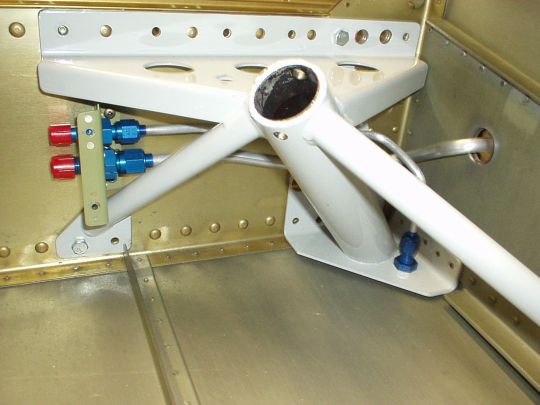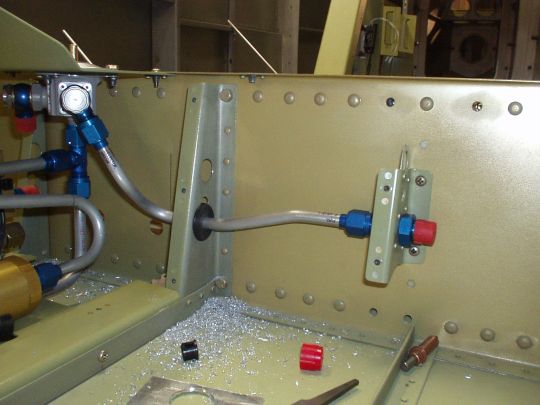



General Notes on Plumbing
This section summarises some
general information I gathered, lessons I learned by experience, and
tactical deviations I made from Van's methods when it comes to the
airplane's plumbing.
Aluminum tubing - 3003 vs. 5052 alloy
Van's uses aluminum tubing
made of 3003-series alloy for all the fuel and brake system
plumbing. However, according to the Standard Aircraft Handbook:
"Aluminum alloy tubing,
1100 (1/2-hard) or 3003 (1/2-hard), is used for general-purpose line of
low or negligible fluid pressures, such as instrument lines and
ventilation conduits. The 2024-T and 5052-0 aluminum alloy materials
are used in general-purpose systems of low and medium pressures, such as
hydraulic and pneumatic 1000- to 1500-psi systems and fuel and oil lines.
Occasionally, these materials are used in high-pressure (3000 psi)
systems."
Pressure in the fuel system
only reaches approximately 25 PSI, which I would say falls under the
category of low or negligible pressure. So there shouldn't be a problem
there (although the Standard Aircraft Handbook does generally recommend
the use of 5052-0 over 3003 for fuel lines). The hydraulic brake system
however experiences much higher pressures, making the choice of tubing
more critical. According to Matco tech
support (email exchange), the high pressure side of the brake system will
normally experience up to about 600 PSI, and their master cylinders can
exert up to 2000 PSI by design and are tested to 1500 PSI. Matco
recommends that the plumbing have a working pressure of at least 450 PSI
and a burst pressure of at least 1500 PSI. I therefore decided to
use 5052-0 aluminum tubing for the brake system instead of 3003.
5052-0 alloy tubing is readily
available from Aircraft Spruce and Wicks, and is not significantly more
expensive than 3003. As an added benefit, 5052-0 tubing is normally
stocked in straight 12' sections, and can be cut and shipped UPS Ground in straight
sections up to 6' long for only an extra $5 oversize shipping
charge. 3003 alloy tubing is normally stocked and shipped in coils,
and is very tedious to uncoil into something resembling a straight line.
So by necessity for the brake system, and for convenience and added
robustness for the fuel system, I'm replacing all 3003 tubing with 5052-0.
Sealants for pipe thread
Tapered pipe threads, like
National Pipe Thread (NPT) used in some AN fittings, in practice needs a
sealing compound to prevent leaks. There are various compounds made
specifically for this purpose, and for compatibility with specific fluids
that will be carried in the plumbing.
For the fuel system, Van's
recommends a compound called Fuel-Lube. Aircraft Spruce also carries
one called EZ-Turn that they claim is equivalent to Fuel-Lube.
Spruce also carries Bakerseal, which some RV builders use. I haven't
decided yet what I will use. I want to make sure that the compound I
use is compatible with avgas, but preferably also compatible with
ethanol. Just thinking ahead...
Van's doesn't make any
specific recommendations for the brake system. I asked Matco tech
support what they use, and they recommended Loctite 567. I picked
some up at Marshall's. Expensive, about $16 for a 50 mL tube.
According to the datasheet this is compatible with gasoline as well, so I
wonder if this would be good for the fuel too.
A bead of sealing compound
should be applied all the way around the male thread, but leave the first
one or two threads dry to prevent it from getting squeezed to the inside
of the plumbing. Make sure there are no voids. Strange as it seems, there is no
torque spec for NPT thread that I could find. The most common expert
advice I could find was hand-tighten,
then tighten with a wrench until it reaches the desired orientation and
the torque "feels right".
Flaring tube ends
The working end of the flaring
tool should be cleaned and lubricated before each use. Otherwise,
the soft aluminum tube will gall, the inner surface of the flare will come
out rough, and it will not form a good seal. LPS-1 lubricant works
well.
Conical seals for flared fittings
Flared fittings seal by direct
metal-to-metal contact between the flared tube end and the fitting,
pressed together by a sleeve and properly torqued nut. Flared
fittings must be clean, dry (no sealing compounds!!!), and free of even
the slightest scratches or other imperfections to form a good seal.
If there are any slight imperfections in the sealing surfaces of the
fitting and/or the flared tube end, there is a product that can
help. It is essentially a very thin conical gasket made of soft
aluminum that fits between the fitting and the flared tube end. The
idea is that the soft conical gasket is soft enough to extrude and conform
to any slight imperfections in the sealing surfaces, and therefore form a
good seal on both sides.
These conical seals are
specified under Aerospace Standard AS4824, and carried under AS4824 part
numbers by Wicks and Genuine Aircraft Hardware. Aircraft Spruce
sells what appears to be the same thing under the name "DEL
seals" (what is "DEL"???) and claims that they are approved
by the military, aerospace companies, etc. but with no reference to
AS4824. RV builders have reported using the Aircraft Spruce variety
successfully to stop leaks. I've also seen references on the web to
these conical seals under the name SECO, which appears to be a company
that manufactures them.
So it's great having these in
the arsenal to stop leaks. But I'm wondering if there is any reason
not to just use these in all fittings from the get go. Seems like
having a soft sacrificial gasket to form the seal will also help protect
the sealing surfaces on the fittings and flared tube ends such that they
could be removed and reinstalled multiple times without causing
progressive damage. In any case, I don't see any drawback to using
these everywhere, other than added cost and weight, both negligible.
I will ask the question on the forums.
Bulkhead penetrations for aluminum tubing
The problem: plastic snap
bushings. Often times, a run of aluminum tubing must pass
through a number of bulkheads, ribs, and/or skins to get from point A to
point B. Van's design generally deals with this by passing the tube
through a hard plastic snap bushing wherever such a penetration
occurs. This solution appears simple and compact, but does have some
serious drawbacks when it comes to manufacturability and
maintainability. The snap bushings used are SB437-4 for 1/4"
tubing, and SB500-6 for 3/8" tubing. These snap bushings have
outer diameters (i.e. require bulkhead hole diameters) of 0.437" and
0.500" respectively. However, the AN818 flared fitting nuts,
which will be captured by the flare at each end of the tube, have outer
diameters of approx 0.647" (1/4" tube: AN818-4D) and 0.787"
(3/8" tube: AN818-6D). The AN818 nuts are bigger than the holes
cut in the bulkheads for the snap bushings, and therefore cannot pass
through them. Therefore, with Van's approach, the tubing runs would
have to be fabricated (bent, cut, and flared) in place, which would be
very difficult or impossible in some of the tight geometries of the
forward cockpit. And furthermore, after both ends are flared, the
tubing run can no longer be removed without being destroyed (cutting off
one of the flared ends). I didn't like that, so I came up with a set
of alternate approaches.
Solution 1: bulkhead
fittings. Flared tube union bulkhead fittings, such as AN832, can be
used to break up a tubing run into two where it passes through a
bulkhead. This can be especially advantageous in instances where
fabricating the two parts of the tubing run independently is more
feasible, and/or where having the tubing run in two pieces makes them
removable where otherwise as a single piece it would not be. In the
forward cockpit of the RV-7A, both situations exist. The fuel and
brake lines must run through the main landing gear mounts and the fuel
selector valve area, which creates some seriously Escher-esque
geometries. I decided to break up the tubing runs with bulkhead
fittings at the F-782B cover support ribs. This makes it possible to
fabricate the tubing on the workbench, and thence be able to install,
remove, and reinstall without destroying anything. This did require
me to modify the F-782B cover support ribs to place the penetration holes
further apart from each other, to make room for the bulkhead fittings.


The downsides of breaking up
the tubing runs with bulkhead fittings are the weight penalty (the
fitting), and more importantly, the addition of a failure point that could
form a leak. Therefore, bulkhead fittings should be used
judiciously, only where breaking up the run offers a definite advantage.
Note that a simple
(non-bulkhead) union fitting such as AN815 could also be used to break up
a run where not passing through a bulkhead. But I don't really like
the idea of having a substantial mass (the fitting) suspended unsupported
in the middle of a tubing run. And since we have to deal with
bulkhead penetrations all over the place anyhow, it makes sense to just
use one of them for the union location. Also, the bulkhead fittings
offer the advantage that they can be installed with or without one or both
of the tubing pieces, and therefore can act as an exact reference for
fitting the two tubing pieces independently of each other.
Solution 2: rubber
grommets. In places where a tubing run must pass through a
bulkhead, but braking up the run with a bulkhead fitting is not warranted
(see above), an MS35489 (a.k.a. AN931) rubber grommet can be used.
The idea is similar to the plastic snap bushings Van's uses, but the
rubber grommets offer some significant advantages. Most notably, the
rubber grommets are available in dimensions where the outer groove
diameter (i.e. the required bulkhead hole diameter) is much bigger than
the inner diameter (i.e. the tube diameter), big enough for the AN818 nut
to pass through the hole in the bulkhead. Specifically, for
1/4" tubing I use MS35489-7 (AN931-4-12), which has an outer groove
diameter of 3/4", and for 3/8" tubing I use MS35489-12
(AN931-6-16), which has an outer groove diameter of 1". These
grommets should nominlally be slipped onto the tubing before flaring,
because they will be captured by the flares and nuts. But even if
they had to be replaced, a grommet could be cut with a sharp knife,
slipped onto the tube, and then glue a "seam" where it was
cut. Because the grommets are made of flexible rubber, they can be
squeezed into position in the bulkhead even with the tube already going
through them. Therefore, the tubing can be removed and replaced
multiple times with no damage to the tubing, and only gradual wear on the
grommets, which could always be replaced if they became too worn. An
additional advantage of the grommets is that they provide a gentler
"shock mount" for the tubing than the hard plastic snap
bushings, while still providing good support. A slight disadvantage
to the grommets compared to the plastic snap bushings is weight.
I used these grommets instead
of snap bushings at the F-783B cover support ribs. Note that this
also required me to modify the F-783B, such that there is enough room for
the big grommets for both fuel and brake lines. In fact, what I did
was to use the top hole (enlarged to 3/4"), which was intended for a
wiring run, for the brake line, and the bottom hole (enlarged to 1")
for the fuel line, for which it was originally intended. I'll cut
another hole for the wiring run somewhere above.

References